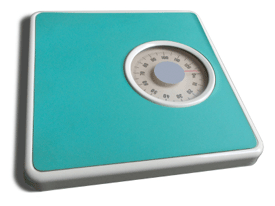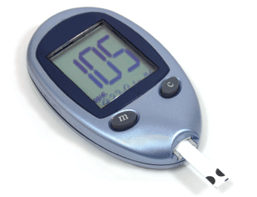Spring 2007: To Your Health
In this Issue:
- National Nutrition Month 2007: Enjoy a “100% Fad Free” Lifestyle
- American Diabetes Alert Day: Are you at Risk?
- Are Probiotics Useful in Irritable Bowel Syndrome?
- Turn off the TV and Turn on Your Life
- Using the DASH Eating Plan to Treat Hypertension
- Osteoporosis Awareness and Prevention
- Feature Food of the Month: Mango
- Healthy Recipe: Sweet Mango Crumble
National Nutrition Month 2007: Enjoy a “100% Fad Free” Lifestyle

The first National Nutrition Month Campaign was launched in 1973 by the American Dietetic Association (ADA) as an opportunity to focus attention on the importance of making knowledgeable food choices and developing healthy eating and physical activity habits. Each year, the theme of National Nutrition Month has differed, from “Say Yes to Less (Less Fat, Less Salt, Less Sugar)” or “Juggle the Foods You Eat”, to “Step Up to Nutrition & Health”. This year in 2007 the American Dietetic Association says “the most effective long-term way to achieve a healthful lifestyle is to be 100% Fad Free”. ADA defines “food fads” as “unreasonable or exaggerated beliefs that eating (or not eating) specific foods, nutrient supplements or combinations of certain foods may cure disease, convey special health benefits or offer quick weight loss.”
According to the ADA, “the reality is, no ‘super food’ or diet approach can reverse weight gain resulting from overeating and inactivity. And because most fad diets don’t teach new eating habits and many require you to give up your favorite foods, people usually don’t stick with them.” Due to the increasing trend of fad diets in our nation, the following tips will be helpful to aid in evaluating a new product, recommendation or diet.
- If it sounds too good to be true, it is – especially if the diet or product offers a “quick fix.”
- Avoid products offering a guaranteed cure or which promote “limited-time offers.”
- Watch out for products that describe certain foods as “good” or “bad.”
- Is the source of the information – such as a book author – also trying to sell a product, like supplements?
- Avoid diets that recommend avoiding major food groups.
Fad diets are a craze. People follow the latest fad for quick results only to be disappointed after they regain the weight. There have been countless reputable studies over many years which have shown that balance and variety are needed for good health. Any diet that requires you to give up whole categories of foods and to take supplements to replace their nutrients is, by definition, unbalanced.
National Nutrition Month Key Messages to Enjoy a 100% Fad Free Lifestyle:
- Develop an eating plan for lifelong health. Too often, people adopt the latest food fad rather than focusing on overall health. Get back to basics and use the new Dietary Guidelines for Americans and MyPyramid as your guide to healthy eating.
- Choose foods sensibly by looking at the big picture. A single food or meal won’t make or break a healthful diet. When consumed in moderation in appropriate portions, all foods can fit into a healthful diet.
- Learn how to spot a food fad. Unreasonable or exaggerated claims that eating (or not eating) specific foods, nutrient supplements or combinations of foods may cure disease or offer quick weight loss are key features of fad diets.
- Find your balance between food and physical activity. Regular physical activity is important for your overall health and fitness plus it helps control body weight, promotes a feeling of well-being and reduces the risk of chronic diseases.
- Food and nutrition misinformation can have harmful effects on your health and well-being, as well as your wallet. Registered dietitians are uniquely qualified to communicate current and emerging science-based nutrition information and are an instrumental part of developing a diet plan that meets your individual needs.
BRG Dietetics & Nutrition, P.C. offers several services
to fit your nutritional needs.
Click here to see how we can help!
American Diabetes Alert Day: Are you at Risk?

March 27th, 2007 is American Diabetes Alert Day. The American Diabetes Alert day is held annually, every fourth Tuesday in March to raise awareness on the impact in which diabetes has on our nation. Diabetes Alert Day promotes an easy way to educate people on the lifestyle changes which may be necessary in order to prevent diabetes.
What is diabetes?
Diabetes is a silent disease in which any individual could have for years and years, and never even know it. Approximately 6.2 million Americans have undiagnosed diabetes. By making yourself and your family aware of the risk factors which can lead to diabetes, you can help prevent the onset of the disease! Diabetes means that your blood glucose, otherwise known as blood sugar, is too high. Too much glucose in the blood is not good for your health. Your eyes, nerves, and kidneys may become harmed by too much sugar in your blood.
Who is at risk for diabetes?
Risk for developing diabetes increases as one ages, gains weight, or does not stay active. Diabetes is a disease which can happen to anyone; however it is most common in African Americans, Latinos, Native Americans, Asian Americans and Pacific Islanders.
Risk factors for diabetes include:
- Family history of diabetes
- Obesity
- Age greater than 45 years
- Gestational diabetes or delivering a baby weighing more than 9 pounds
- High blood pressure
- High blood levels of triglycerides
- High blood cholesterol levels
Symptoms
Symptoms of type 1 diabetes:
- Increased thirst
- Increased urination
- Weight loss in spite of increased appetite
- Nausea and/or vomiting
- Fatigue
Symptoms of type 2 diabetes:
- Increased thirst
- Increased urination
- Increased appetite
- Fatigue
- Blurred vision
- Slow-healing cuts
If you have any of the above mentioned risk factors or symptoms, contact your healthcare provider.
To lower your risk of type 2 diabetes, maintain a healthy body weight, keep to an active lifestyle, and eat low fat meals that are high in whole grains, fruits and vegetables.
For an overview of diabetes meal planning, visit our special web section.
Are Probiotics Useful in Irritable Bowel Syndrome?

If you have irritable bowel syndrome, you are not alone! Irritable bowel syndrome affects 10-15% or more of the general population.
Irritable bowel syndrome, or IBS, is generally classified as a “functional” disorder. A functional disorder refers to a “disorder of functioning” where the body’s normal activities [in terms of the movement in the intestines, the sensitivity of the nerves of the intestines, or the way in which the brain controls some of these functions] are impaired. Irritable bowel syndrome may also be referred to as spastic colon, mucous colitis, spastic colitis, nervous stomach, or irritable colon. The symptoms of irritable bowel include abdominal pain or discomfort, which may be associated with a change in bowel pattern, such as loose or more frequent bowel movements, diarrhea, and/or constipation. While dietary factors do not cause IBS, certain foods appear to aggravate symptoms, or make a person feel worse.
There is suggested evidence that probiotics may help to manage the discomfort associated with IBS. Probiotics are live strains of ‘good’ bacteria that enable our digestive system to properly function. Processed foods, antibiotics, and pollution greatly reduce the number of naturally-occurring bacteria in the intestine, and research suggests that consuming foods with natural probiotics increases the number of ‘good’ bacteria, thereby improving our digestive system. The most common type of probiotics are strains of Lactobacilli and Bifidobacteria, which are found in yogurts and other cultured dairy products. Probiotics are also added to a variety of fortified foods and beverages and are available as dietary supplements.
In a study published by the American Journal of Clinical Nutrition, 251 patients with post-colitis IBS were treated with either of two types of probiotic formulas—VSL #3 (high concentration containing Bifidobacteria, Lactobacilli acidophilus among others) or Bioflorin (a standard preparation, which served as the control)—for ten consecutive days. This process is referred to as “oral bacteriotherapy”. Results of the study revealed significant greater improvement in intestinal gas and abdominal pain in patients who were given the VSL #3 formula as compared to the standard. There was no significant differences between the 2 groups seen in relation to constipation and diarrhea, however there was significant improvement seen in both groups in these parameters as compared to baseline. The study concluded that oral bacteriotherapy can be an effective therapeutic strategy to manage post-colitis IBS and that high bacterial concentrations and the presence of several different strains can add to the effectiveness of treatment.
While we do have research that supports the benefits of probiotics, more studies are needed using different strains and amounts of bacteria to help draw firm conclusions.
Look for a discussion about prebiotics in a future issue of To Your Health!
Reference: De Simone C, Famularo G, Bianchi Salvadori B, Moretti S, Marcellini S, Trinchieri V, Santini G. “Treatment of irritable bowel syndrome (IBS) with the newer probiotic vsl#3: a multicenter trial. American Journal of Clinical Nutrition. 2001; 73.2: 491S.
Turn off the TV and Turn on Your Life

National TV-Turnoff Week is April 23 – 29, 2007.
On average, children in the U.S. will spend more time in front of the television (1,023 hours) than in school each year (900 hours). Forty percent of Americans frequently or always watch television during dinner. If you or your family falls into these statistics, TV-Turnoff Week may be just what you need!
TV-Turnoff Week began in 1995. During this week, both children and adults took part through schools, churches, and community groups to connect with their families and communities. TV-Turnoff Week gives us a chance to “think, read, create and do”. Many studies show that television cuts into family time, harms our children’s ability to read and succeed in school, and contributes to unhealthy lifestyles and obesity.
Obesity is an epidemic in this country. One in four adults and one in ten children are considered obese. Turning off the TV is a great way to improve the health of you and your family. Cutting back on television will give you the opportunity to play outside, take a walk, or pick up a new sport. According to follow-up surveys, almost three out of four past TV-Turnoff Week participants said they exercised more during the week. There is no activity that we do while we are awake that burns fewer calories than watching TV.
In a 2005 study which took place in six northern California public elementary schools, data was collected from a sample of third grade students and their parents through classroom surveys and telephone interviews. Academic achievement of these third graders was assessed through the mathematics, reading, and language arts sections of the Stanford Achievement Test. The results of this study showed that the household media environment is significantly associated with students’ performance on the standardized tests. It was found that having a television set in a child’s bedroom was significantly and negatively associated with students’ test scores, while home computer access and use were positively associated with the scores.
The following tips will help you and your family cut back on TV watching:
- Turn the TV off during mealtime.
- Make at least one day during the week a TV-free day.
- Do not allow your child to have a TV in his/her bedroom.
- Exercise as a family. You can do activities such as going for a walk or riding your bikes.
- Remember, you are your child’s role model. Set a good example by turning off the TV, eating better and exercising more.
Visit our special web section for interesting facts and figures about our TV habits.
Reference: TV-Turnoff Network Arch Pediatr Adolesc Med. 2005; 159:607-613
Using the DASH Eating Plan to Treat Hypertension

May is National High Blood Pressure Education Month. Take time this month to learn about high blood pressure and decrease your risk factors for hypertension and other heart related diseases. It is estimated that one in every four American adults has high blood pressure. High blood pressure increases your risk for heart disease and for having a stroke. It is especially dangerous because it often has no warning signs or symptoms. Regardless of race, age, or gender, anyone can develop high blood pressure.
The DASH (Dietary Approaches to Stop Hypertension) eating plan has received a lot of publicity in the last few years. The DASH eating plan focuses on limiting saturated fat and cholesterol as well as increasing the intake of foods high in potassium, calcium, and magnesium, lean protein, and fiber. The National Heart Lung and Blood Institute recently conducted two studies, each focusing on lowering sodium intake and following the DASH eating plan. The first DASH study involved 459 adults with systolic blood pressures of less than 160 mmHg and diastolic pressures of 80-95 mmHg. The DASH study compared three eating plans: a plan that included foods similar to what most Americans regularly eat; a plan that includes foods similar to what many Americans regularly eat plus more fruits and vegetables; and the DASH eating plan. All three plans contained 3,000 milligrams of sodium daily. Participants who followed the plan that included more fruits and vegetables and those following the DASH eating plan had shown significantly reduced blood pressure. However, the DASH eating plan had the greatest effect, especially for those with high blood pressure.
The second DASH study looked at the effect of a reduced dietary sodium intake on blood pressure. Participants followed either the DASH eating plan or an eating plan typical of what many Americans consume. This second study involved 412 participants. Participants were randomly assigned to one of the two eating plans for one month at each of one of three sodium levels. The three sodium levels were 3,300 milligrams per day (the average amount consumed by Americans), an intermediate intake of about 2,300 milligrams per day, and a lower intake of about 1,500 milligrams per day. Results showed that reducing dietary sodium lowered blood pressure for both eating plans. At each sodium level, blood pressure was lower on the DASH eating plan than on the other eating plan. The greatest blood pressure reductions were seen with the DASH eating plan at the sodium intake of 1,500 milligrams per day.
Both of these studies can conclude that following a low sodium plan and the DASH eating plan can aid in significant blood pressure control.
The level of physical activity of an individual also impacts blood pressure. The February issue of the Journal of Adolescent Health highlighted a study of 4,500 American adolescents, 12-15 years of age, and the effect of their lifestyles on high blood pressure. They found that sedentary activities and higher body mass index (BMI) were associated with higher systolic blood pressure. Systolic blood pressure is the pressure in the arteries when the heart contracts and diastolic blood pressure is between heart beats. Within the 12 to 15-year-old age group, the study team recognized higher blood pressure to be especially associated with higher levels of watching television, a popular sedentary activity amongst the youth of America. This study also offered significant information that adolescents spend several hours per day in sedentary activities. According to Yasuki Kobayashi, M.D., Ph.D, a co-author of this study “high blood pressure in adolescents is predictive of hypertension in adulthood, and in addition, adolescent obesity is a predictor of obesity and cardiovascular risk factors in young adulthood and beyond.” Being physically active is one of the most important things you and your family can do to prevent or control high blood pressure.
- Click here to get started on your DASH Eating Plan.
- For easy everyday suggestions to increase your physical activity, click here!
- Visit our special web section to learn what your blood pressure numbers mean!
Reference: National Heart Lung and Blood Institute
The DASH studies were sponsored by the NHLBI and conducted at four medical centers. There was also a central coordinating center at Kaiser Permanente Center for Health Research in Portland, OR. The four medical centers were: Brigham and Women’s Hospital, Boston, MA; Duke Hypertension Center and the Sarah W. Stedman Nutrition and Metabolism Center, Durham, NC; Johns Hopkins Medical Institutions, Baltimore, MD; and Pennington Biomedical Research Center, Baton Rouge, LA.
Osteoporosis Awareness and Prevention

Osteoporosis is a condition of porous bone in which the bones are brittle and weak and fracture easily. These fractures occur typically in the hip, spine, and wrist. According to the National Osteoporosis Foundation [NOF], osteoporosis is a major public health threat for an estimated 44 million Americans or 55 percent of the people 50 years of age and older. In the U.S., 10 million individuals are estimated to already have the disease and almost 34 million more are estimated to have low bone mass, placing them at increased risk for osteoporosis. Of the 10 million Americans estimated to have osteoporosis, 8 million are women and 2 million are men.
May is National Osteoporosis Awareness and Prevention month. Make this month the one in which you take the necessary steps in preventing osteoporosis. Engaging in regular exercise and assuring your diet has the adequate amounts of calcium and vitamin D are essential in osteoporosis prevention. In January 2007, The Food and Drug administration proposed to allow manufacturers to include new information and new claims on their food and supplement labeling containing calcium and vitamin D to show their potential to reduce the risk of osteoporosis. This new labeling will help consumers select foods that provide adequate calcium and vitamin D intake in the hope of preventing the occurrence of osteoporosis.
There are many other nutrients besides calcium and vitamin D that are found in dairy products, such as phosphorus, potassium, and protein, that work together to help protect bones. The National Dairy Council is hard at work at advertising these benefits to consumers so that there is a better understanding of the importance of three daily servings of dairy to obtain these nutrients and reduce the risk of osteoporosis.
One way to increase the amount of calcium in your diet is incorporate calcium-rich foods, such as low fat milk, low fat cheese, canned salmon and broccoli. Most people know that dairy products contain calcium, but most are unaware that low fat dairy products actually have more calcium per serving than their higher fat versions, such as whole milk. Certain foods are fortified with calcium, which means they have calcium added to them. These foods, such as orange juice, cereals and breakfast bars make it easier to consume calcium than ever before!
Vitamin D is an important vitamin to include in your diet everyday to promote healthy bones and to aid in calcium absorption, all while preventing osteoporosis. Vitamin D is made naturally in ones body, following direct exposure to the sun. The amount of vitamin D produced in the skin varies depending on the time of day, season, latitude and ones skin color. As adults age, ones ability to make vitamin D through the skin decreases. Those who are housebound and experience no sunlight exposure are unable to make vitamin D. This is why incorporating vitamin D into your food choices is very important in preventing osteoporosis.
The major food sources of vitamin D are fortified dairy products (milk and yogurt), egg yolks, and saltwater fish (salmon, tuna, sardines and mackerel). Some calcium supplements and most multivitamins contain vitamin D as well.
Try these convenient snack ideas to help you boost your calcium and vitamin D intake:
- Layer low fat American cheese onto crackers.
- Alternate small slices of apples and reduced fat Cheddar cheese on skewers.
- Enjoy low fat vanilla yogurt with a bowl of fresh berries.
- Make your own tropical smoothie – blend fresh orange slices with low fat strawberry yogurt and ice, or try blending mango, plain low fat yogurt and a splash of pineapple juice.
- Mix canned salmon with nonfat Ricotta or Mozzarella cheese and spread on pita wedges.
- Stock up on light string cheese for an easy “on the go” snack!
- Mix ½ cup shredded light cheese with popcorn and pretzels.
- Top whole wheat crackers with reduced fat cheese and cherry tomatoes.
- Try fat-free flavored milks, such as strawberry milk for a nice change.
Visit our special web section for a list of calcium-rich foods.
Reference: National Osteoporosis Foundation
Feature Food of the Month: Mango, the ‘King of Fruit’

The mango originated in Southeast Asia, where it has grown for over 4000 years. Most of the mangos sold in the United States are imported from Mexico, Haiti, the Caribbean and South America. Today there are over 1,000 different varieties of mangos throughout the world and are known by many as a comfort food! Mangos are not only delicious but they are rich in vitamins, minerals and antioxidants. Mangos also contain an enzyme with stomach soothing properties. These comforting enzymes act as a digestive aid and can be held partially responsible for that feeling of satisfaction after enjoying a delicious mango, making it perfectly normal to actually crave mangos!
Mangos are an excellent source of fiber, potassium, vitamins A and C and beta carotene! An average sized mango can contain up to 40% of your daily fiber requirement. When selecting mangos, choose those that have a full, fruity aroma coming from the stem. This will indicate ripeness. Mangos are ready to eat when they are slightly soft to the touch. Mangos will have the best flavor when they have a yellow tinge when ripe. Store your mangos at room temperature until ripened. Then refrigerate and use within a few days.
1 Mango, no skin or seed- 7.3 oz
135 Calories
0.6 g Total Fat
0.1 g Saturated Fat
0 mg Cholesterol
4 mg Sodium
35.2 g Carbohydrates
3.7 g Fiber
1.1 g Protein
322.9 g Potassium
Healthy Recipe – Sweet Mango Crumble

Ingredients:
¼ cup whole wheat flour
½ cup all-purpose flour, divided
½ cup toasted wheat germ
¾ cup old-fashioned oats
½ cup Splenda Brown Sugar Substitute®
¼ cup chopped walnuts
1 ½ tsp. ground cinnamon
2 tbsp. Smart Balance Light® margarine, melted
3 yellow delicious apples
3 red delicious apples
3 tbsp. lemon juice
2 mangos, peeled and chopped
Instructions:
- Preheat the oven to 375 degrees F. Spray a 13 x 9 inch baking dish with nonstick cooking spray.
- Mix together ¼ cup all-purpose flour, whole wheat flour, wheat germ, oats, Splenda Brown Sugar Substitute®, walnuts, and cinnamon in a bowl. Stir in melted Smart Balance Light® margarine and set aside.
- Core the apples and chop. Spritz with lemon juice and stir. Mix in remaining ¼ cup all-purpose flour; gently fold in mango.
- Place the apple and mango mixture in the prepared baking dish. Sprinkle the flour-oat mixture evenly over the top. Bake for 45 minutes, until the apples are tender.
Yield: 18 servings
Serving Size: 1 cup
Exchanges: 1 Fruit, ½ Starch, ½ Fat
Nutrition Facts:
Calories = 125
Total Fat = 2 grams
Saturated Fat = 0.4 grams
Cholesterol = 0 milligrams
Protein = 2 grams
Carbohydrate = 24 grams
Sodium = 12 milligrams
Dietary Fiber = 3 grams
Original recipe from the American Dietetic Association; modified by BRG Dietetics & Nutrition, P.C.
For more healthy recipes, click here.

Leave a Reply
Want to join the discussion?Feel free to contribute!